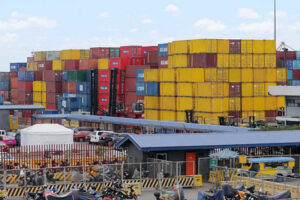TRADE DIVERSION in Asia arising from the United States’ reciprocal tariff orders could benefit the Philippines as it is one of the few countries slapped with a lower tariff.
“This time around, the US tariffs are imposed globally, with differing tariff hikes across countries,” Nomura Global Markets Research said in a report.
“This could result in US firms replacing some of their imports from countries that have higher tariffs (e.g. Thailand, Vietnam) with imports from countries that have lower tariffs (e.g. Philippines).”
US President Donald J. Trump on April 2 announced the imposition of a baseline tariff of 10% on all its trading partners. Some countries were hit with higher-than-expected tariffs, with the Philippines facing a 17% tariff that will be implemented starting April 9.
Nomura said trade diversion benefits to the low-tariff countries could be a “partial offset.”
“There may be some scope for trade diversion, as some countries have higher tariff rates than others.”
“Back in 2017-18, US tariffs on China resulted in US firms replacing some of their imports from China with imports from other countries, including those in Asia,” it added.
In the region, the Philippines has the second-lowest tariff rate, just after Singapore, which received the 10% baseline tariff.
Countries that were recipients of “moderate” tariffs (24% to 27%) were Japan, South Korea and India.
Meanwhile, Cambodia, Vietnam, Thailand, Indonesia and China bore the brunt of higher tariffs (32% to 49%).
“Higher reciprocal tariffs will also influence the next round of supply-chain shifts. During the last eight years, Southeast Asian countries such as Vietnam have benefited from US-China trade tensions,” Nomura said.
“Higher reciprocal tariffs on Vietnam and Cambodia, if they are sustained, will eliminate this advantage. Instead, India, which faces a 27% reciprocal tariff and is trying to negotiate this down, stands to benefit from the next round of supply-chain shifts, helped also by its strategic alliance to the US.”
The Philippines’ top destination for exports is the United States, accounting for about 17% of the total in 2024.
Data from Nomura showed that US exports accounted for 2.6% of the Philippines’ gross domestic product last year.
“For the same reason, we would put the Philippines in this relatively less affected camp because of the government’s drive to implement infrastructure projects.”
Meanwhile, Nomura noted the potential channels that could be affected by tariffs, such as electronics, machinery and textiles sectors.
“Product-wise concentration (US exposure) is a concern for textiles (Indonesia, Philippines, Vietnam), machinery (Korea) and electronics (Thailand),” it said.
Around 35% to 45% of the Philippines, Indonesia and Vietnam’s textile exports go to the US. “This means that the impact on specific sectors might be more severe in some economies,” it added.
Meanwhile, ING Bank in a separate report said the Philippines will still experience spillovers from the US tariff order.
“Although the Philippines is relatively well-positioned with a lower tariff rate and reduced exposure to US exports, it is unlikely to remain completely unaffected,” it said.
These tariffs could “exert downward pressure on US growth and the Federal Reserve to cut rates.”
“The gloomier near-term outlook for the economy means that risks are skewed to the central bank having to do more this year,” ING said.
“This should take away concerns around the Philippines cutting rates too fast too soon, and staying largely aligned with US rate actions.”
The Bangko Sentral ng Pilipinas held interest rates steady in February due to the uncertainties from global trade policies.
All 17 analysts surveyed in a BusinessWorld poll expect the Monetary Board to cut rates by 25 basis points on Thursday. — Luisa Maria Jacinta C. Jocson
